How to Plan an Overnight Kayak Trip to Lake Powell’s Labyrinth Canyon
Learn the logistics for planning an overnight kayak trip on Lake Powell, including the best places to paddle & camp, where to rent kayaks & the ideal time to visit.
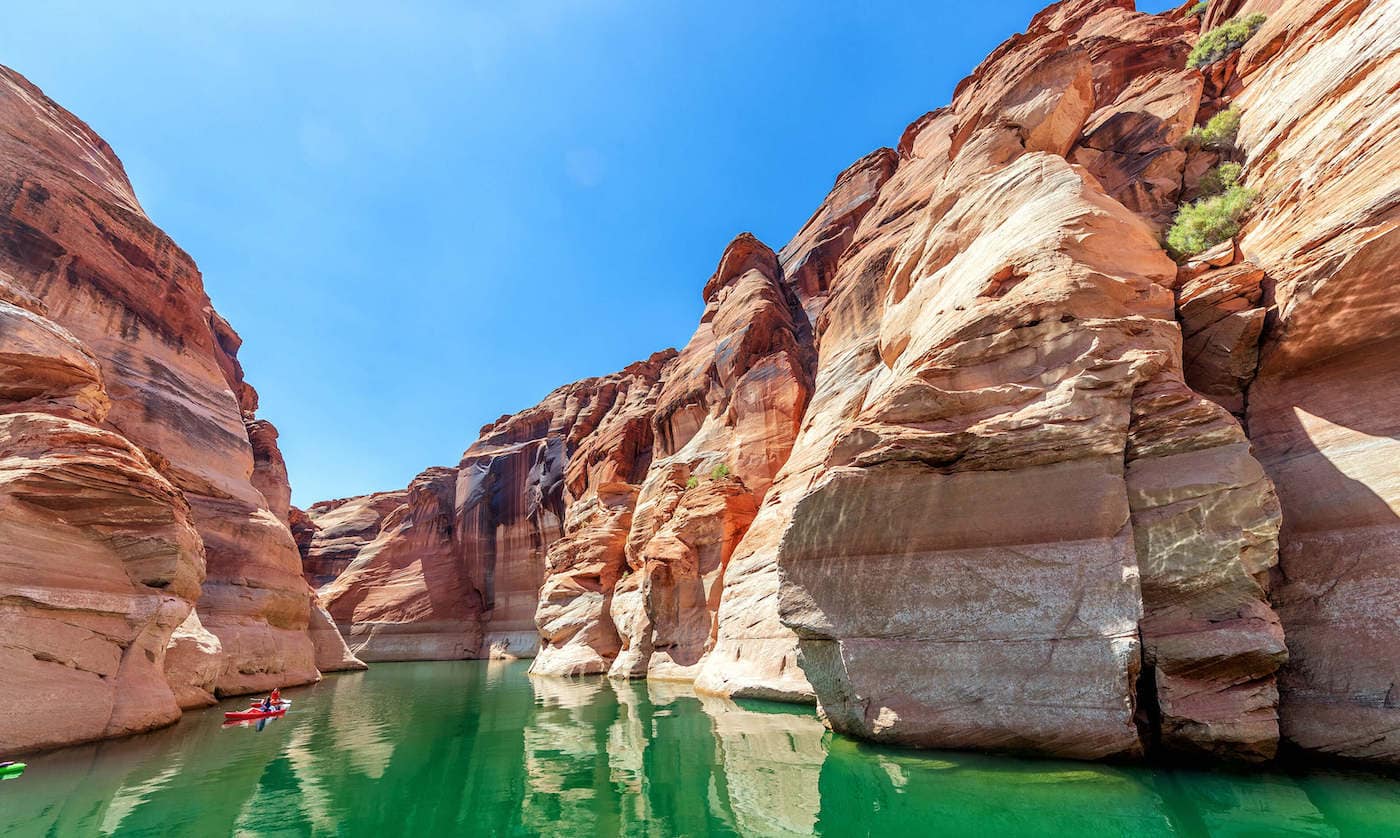
Have you ever wanted to explore one of the most remote and beautiful places on earth? Well, an overnight kayak trip to Lake Powell’s Labyrinth Canyon is the perfect way to do just that! This remote corner of Arizona and Utah is a paddling paradise, with hundreds of miles of winding canyons to explore.
In this blog post, I share a step-by-step guide on planning an overnight kayak trip to Lake Powell’s Labyrinth Canyon. From what gear to bring to where to camp, this post will cover everything you need to know for a successful and enjoyable trip. So whether you’re a seasoned paddler or totally new to the sport, read on for all the info you need for an unforgettable adventure in one of Arizona’s most beautiful places.
Start planning your Lake Powell kayak trip with this complete guide!
Important Reminder: As outdoor recreationists, it’s our responsibility to know how to recreate responsibly on the water whether we’re kayaking, paddleboarding, canoeing, rafting, or boating. Learn how to prevent the spread of aquatic invasive species with 3 easy steps that have a huge impact on our ecosystems.
Why Kayak Lake Powell?
Lake Powell is a super scenic 200-mile long reservoir on the Utah/Arizona border filled with remote canyons and many secluded beaches.
The lake is commonly enjoyed by houseboat or motorboat, but these can be expensive to rent and they don’t allow you to get into the quieter and more remote areas of the reservoir like Labyrinth Canyon. This is why we recommend kayaking Lake Powell if you really want to explore all this area has to offer. You’ll also get a little exercise, to boot!
The prime (and free) beach camping, mysterious canyons, and quiet paddling made my Labyrinth Canyon kayaking trip on Lake Powell one of my favorite southwest adventures to date.

Lake Powell Map
Lake Powell is located on the Utah / Arizona border in the Glen Canyon National Recreation Area. The area covers 254 square miles and has dozens of tributaries, canyons, and waterways to explore.
There are several Visitor Centers and launching points on Lake Powell, but if you plan on kayaking Labyrinth Canyon, I recommend starting in Page, Arizona. The closest international airports to Page are Las Vegas and Phoenix, both 280 miles away.
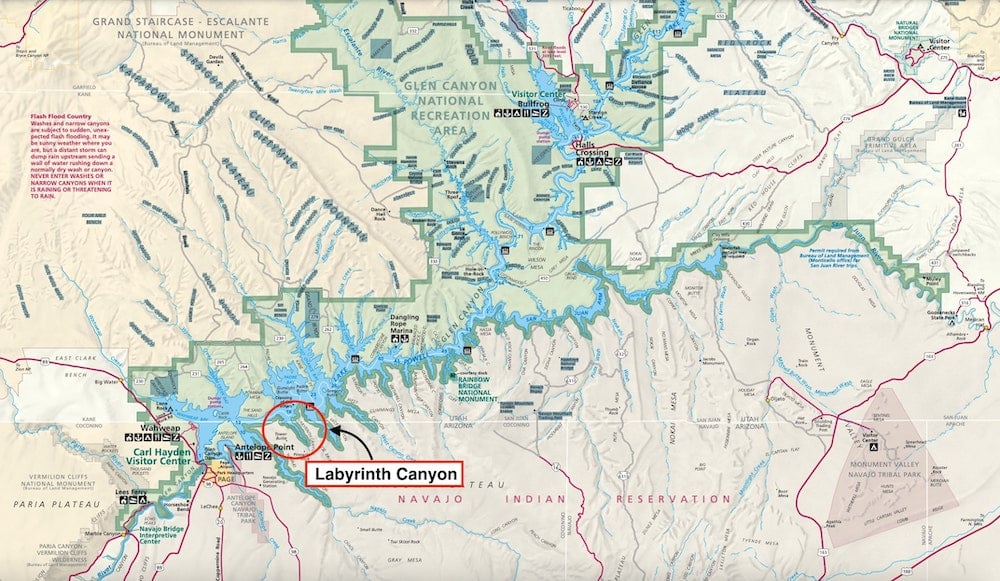
How to Plan an Overnight Labyrinth Canyon Kayak Trip
1. Choose your starting point
There are several marinas and launching points located around Lake Powell. We started our trip out of Page, Arizona where there are two large marinas, a couple of kayak rental companies, and other services that made it a convenient launching point.
The two biggest marinas near Page are Wahweap (where we launched from) and Antelope Point. We chose to launch at Wahweap because it was the most convenient for us and we could hire a water taxi to get us to Labyrinth Canyon to start our trip (more on water shuttles below).
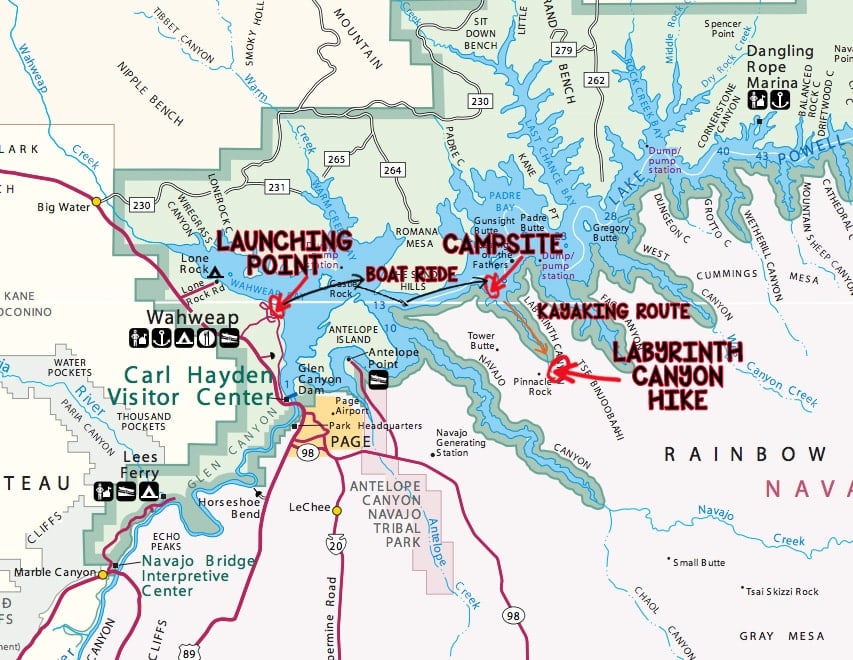
In addition to the established marinas, you can also launch at any of the primitive beach camping areas around Page such as Lone Rock, which is a popular starting point for folks who don’t have access to boat transportation or don’t want to pay for a water taxi.
If you are coming from Salt Lake City, you might also consider accessing the lake from the Utah side at Bullfrog or Hite Marinas. However, services at these marinas are more limited and it’s a much longer boat ride down to Labyrinth Canyon.
No matter where you enter Glen Canyon National Recreation Area, you must pay the $30 entrance fee per car, which grants you 7-day admission and overnight parking. However, if you have an annual National Park Pass, the fee is waived.
2. Reserve a Lake Powell Kayak Rental
If you don’t have your own kayak, you’re in luck! There are several places to rent kayaks in Page, Arizona. We rented two single touring kayaks from Kayak Lake Powell and the price was very reasonable. Each kayak had plenty of room to store gear, including tents, sleeping bags, clothes, water, and food.
Kayak Lake Powell also offers sit-on-top kayaks, but I don’t recommend these for an overnight kayaking trip since they aren’t as efficient to paddle and they don’t have storage compartments for gear.
Kayak rentals include a life jacket, a paddle, and free delivery to the Antelope Point Marina if you choose to start from there. Reservations can be made online or by calling their shop.
Kayak Lake Powell also offers guided kayaking trips to Labyrinth Canyon if you prefer a package trip. During our trip, we ran into one other group who was on a guided tour and they seemed to be having a great time.

3. Book a Water Shuttle to Labyrinth Canyon
In order to get to Labyrinth Canyon for a quick overnighter, you must be transported to the mouth of the canyon by a motorboat.
There are two marinas on Lake Powell that provide water shuttles to Labyrinth Canyon: Aramark Executive Services out of Wahweap Marina and Antelope Point Marina.
The ride from Wahweap to the mouth of Labyrinth Canyon, which is what we did, is just under 20 miles and takes about an hour. The ride from Antelope Point Marina to the mouth of Labyrinth Canyon is about 12 miles and 30-45 minutes.
Expect to pay around $150-$200 per hour for a water taxi (as of April 2022). Yes, it’s pricey, but if you have a large group, it could be worth it!
It is possible to kayak to the mouth of Labyrinth Canyon, but I don’t really recommend doing this because the water can be very choppy and you’ll most likely experience a lot of boat traffic along the way. You’ll also need more than one night for your trip if you paddle there and back. It’s much better to hire a motorboat to shuttle you and your gear.
I’ve included several alternative overnight kayaking routes below if you don’t want to book a water shuttle to Labyrinth Canyon.
4. Choose your Camping Spot
Once you are out on Lake Powell, you are allowed to camp anywhere along the shoreline. Most of the camping is primitive in undeveloped sites, meaning there are no services of any kind and camping is free. You also don’t need a permit or reservation.
You are, however, required to carry out all of your waste, including poop and toilet paper. You can do this with a National Park-approved Waste Bag Containment System – otherwise known as a wag bag which you carry out and later throw in the trash.
You’re also allowed to have a campfire, but you must bring your own wood. Just dig a pit in the sand below the high water line, and make sure your fire doesn’t get bigger than 4 feet tall x 4 feet wide. Read more about primitive camping rules and regulations at Lake Powell here.
We camped on the beach at the mouth of Labyrinth Canyon. It was stunning and we had the place to ourselves!
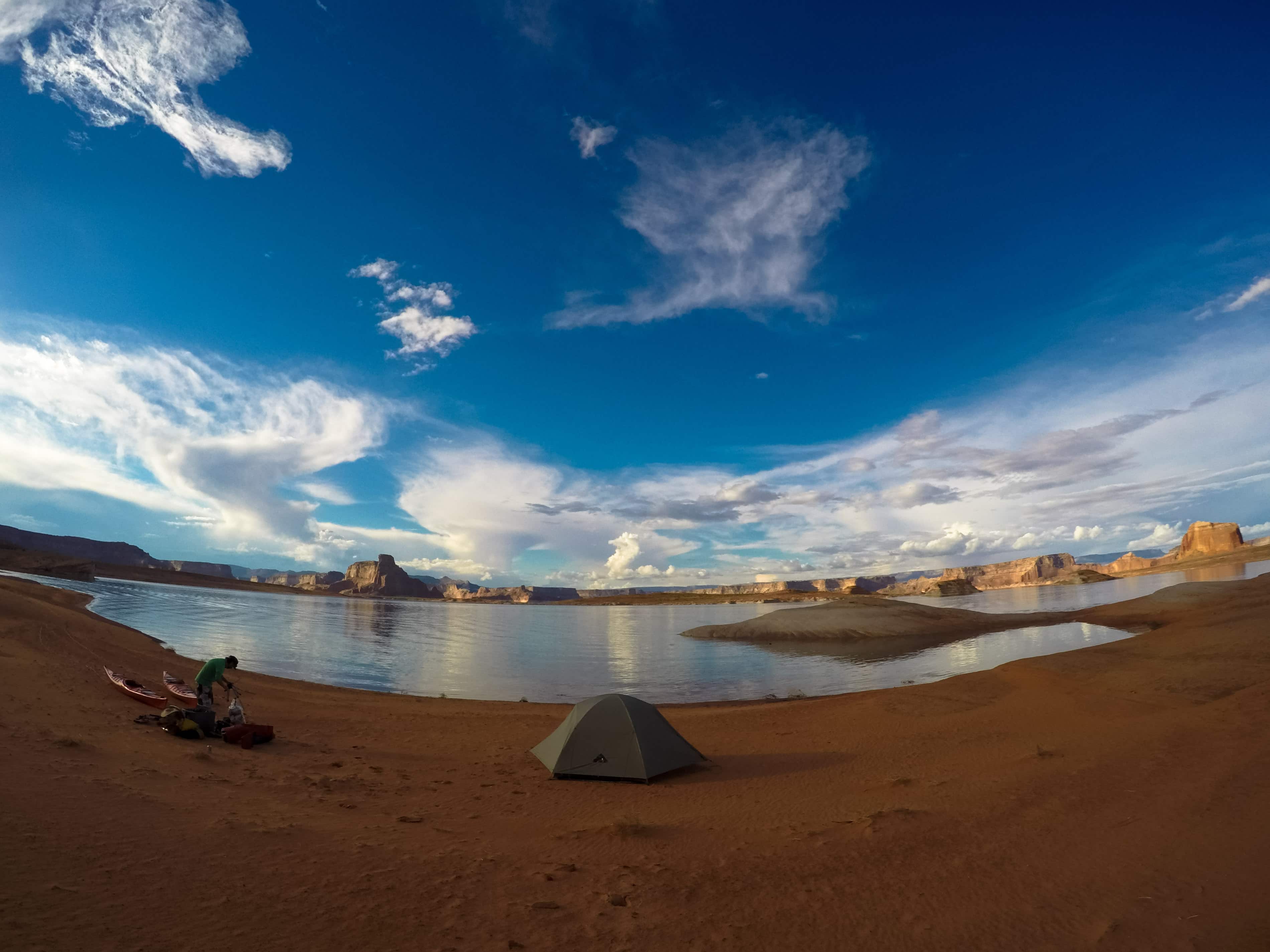
Alternative Lake Powell Kayaking Routes
If you don’t want to pay for the pricey water taxi to Labyrinth Canyon, you can still enjoy an overnight kayak trip on Lake Powell without a water shuttle. The easiest and most economical option is to drive from Page, launch at Lone Rock Campground or Wahweap Marina and then paddle across the lake to Wiregrass Canyon and Lone Rock Canyon. Both of these areas have a ton of options for camping and cool geological features to explore.
Another popular overnight option is to launch at Antelope Point and then kayak over to the mouth of Navajo Canyon. You can camp at the mouth and then explore Navajo Canyon as a day trip.
If you’re still unsure about route options, the staff at Kayak Lake Powell are very knowledgeable and provided us with a lot of advice about where to go on Lake Powell and what to check out. Depending on your time and financial constraints, I’d suggest discussing the different kayaking route options when you call to reserve your kayaks.
Read More
More Overnight Paddling Trips
My Labyrinth Canyon Overnight Kayak Trip Report
After getting shuttled to the mouth of Labyrinth Canyon, we had an awesome night sitting on the beach by the campfire and woke up early-ish the next day so we’d have plenty of time to explore Labyrinth Canyon.
In the morning, we loaded up the kayaks with lunch, water, and gear, and set off.
Finding the entrance to Labyrinth Canyon was pretty easy. If you just hug the south side of the lake, you’ll spill right into it.
As we made our way towards the back of the canyon, the canyon walls closed in and got very tight and It wasn’t long before the canyon was too narrow for most boats. We didn’t encounter any other paddlers until we reached the very end of the canyon where a few other kayakers had pulled their kayaks onto a beach and were off exploring.

At the back of the canyon, we beached our kayaks, threw on some hiking shoes, and started hiking back into the narrows. The walls in some places were more than 200 feet tall and less than 2 feet wide. Eventually, we hit some pools of water. We probed a little deeper, but the water was freezing and some other folks told us that it got quite deep. Not being ready for a canyon swim, we turned around and headed back to our kayaks.
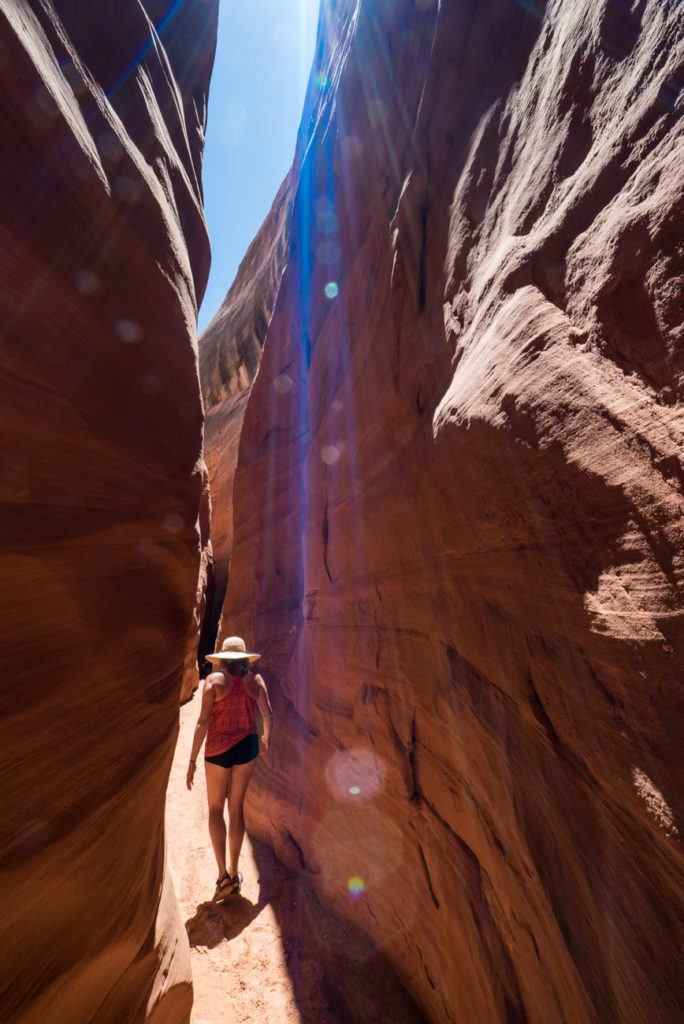
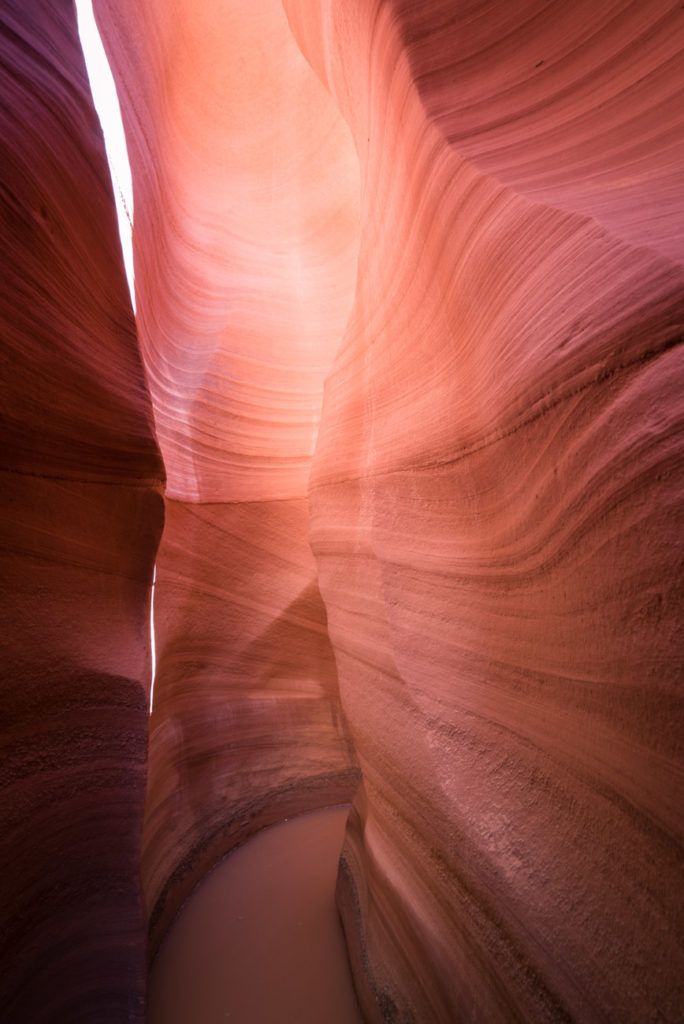
It took us about 6 hours in all to get to the back of the canyon, hike, and return to our campsite at a very leisurely pace with a few stops along the way.
Best Time to Visit Lake Powell
No matter when you visit, keep an eye on the weather prior to your trip. You’ll want to watch out for winds and thunderstorms. The lake can get incredibly choppy and not only would it not be fun to kayak in super rough conditions, but it can also be dangerous.
Spring: I visited Lake Powell in mid-May and got perfect weather. No wind, warm daytime temps, and the water was warm enough to take a quick dip in. That said, you would not want to tip over and if you did, you’d want to be wearing a wet suit. Hypothermia does happen and it is serious.
In spring, the water level is also lower which allows you better access to the back of the canyons and the chance of rain is lower than later in summer.

Summer: Summers tend to be scorching at Lake Powell. Swimming is comfortable, but paddling not so much, at least in the heat of the day. If you plan a Lake Powell kayaking trip in summer, plan to paddle in the early morning and late afternoon and spend the hottest part of the day on the beach swimming.
Other things to keep in mind are that flash floods are highest in July through September and the beginning of summer through Labor Day is the busiest time on the lake.
Fall: Fall is a great time to explore Lake Powell. You can expect very pleasant air and water temps and fewer people.
Winter: Exploring Lake Powell during the winter months is only recommended for experienced paddlers and you should wear a wet suit even when you are in your boat. Days are short, temps are cold, and swimming isn’t possible. However, with the right weather window, Lake Powell can be a very special place in the winter.
What to Pack for your Lake Powell Kayaking Trip
Kayak camping gear is very similar to what you would take with you on a backpacking trip, but you’ll want to take extra precautions to keep everything dry and secure. For a detailed guide on what to pack for your Lake Powell kayak trip, check out our comprehensive guide on kayak camping.
Below are a few recommendations specific to an overnight kayaking trip to Lake Powell.
- Water purifier: The nice thing about kayaking on Lake Powell is that it’s fresh water, so you don’t need to carry a ton of water – you can simply filter water when you need it. My go-to filter is the Playtpus GravityWorks Filter. It’s fast, easy to use, and doesn’t take up much space.
- Wag bags: If you are doing primitive camping along Lake Powell’s shoreline, you are required to carry out all human waste (and toilet paper) in a National Park approved waste contamination system. Basically, that means you have to go poop in a bag. No one likes to do it, but it helps keep the beaches and the water clean of (toxic) waste. So bring a couple of these wag bags.
- GPS communication device: It’s a good idea to carry a GPS communication device anytime you’re in the backcountry. Once you get away from the marina, there is no cell phone service.
- Life jacket: If you are renting a kayak, the kayak company should provide a life jacket. If not, you are required by law to have a life jacket with you on your kayak. I purchased this Stohlquist PFD for a week-long rafting trip and find it to be relatively comfortable to paddle in.
- Lake Powell Map: This waterproof NatGeo map shows all of the side canyons, camping areas, and beaches.
- Layers: Depending on what time of year you are visiting Lake Powell, it’s a good idea to pack several layers. Weather can change quickly on the water, so be sure to pack a warm puffy, a light windbreaker, a rash guard, and some quick-drying t-shirts.
- Dry suit: If you’re paddling on Lake Powell during the winter months, you will need to wear a drysuit even when paddling.
Essential Clothing for Paddling
Goodr Polarized Sunglasses
Polarized glasses are best for the reflection of the water. I like to wear budget-friendly sunglasses paddling and I always wear a retainer so I don’t lose them in the water.
Shop at:
One night was barely enough to scratch the surface of this magical place, but even so, it was worth the effort to get to Labyrinth Canyon. I’m officially hooked on Lake Powell, and I can’t wait to go back to explore more.
Have you kayaked on Lake Powell? What did your trip look like? What questions do you still have? Leave a comment below!

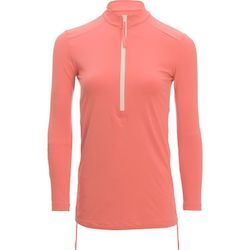
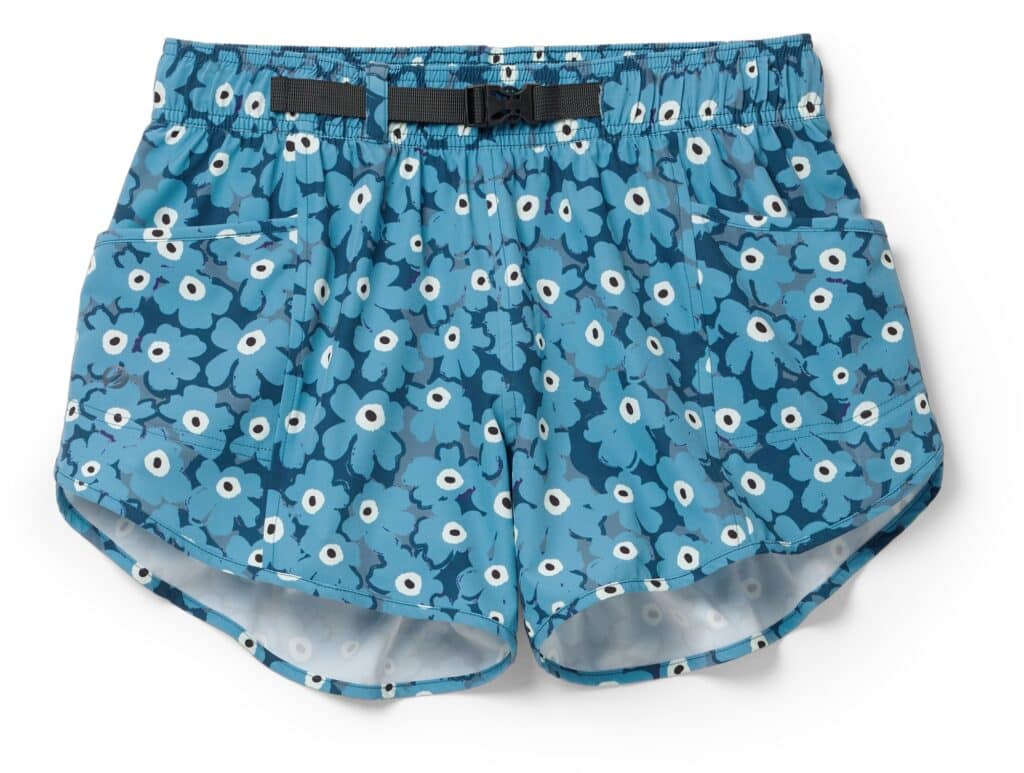


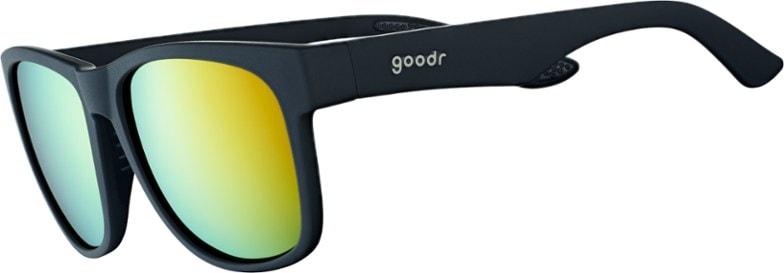
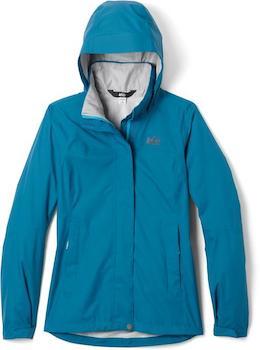
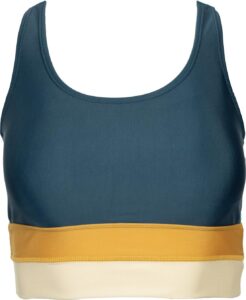
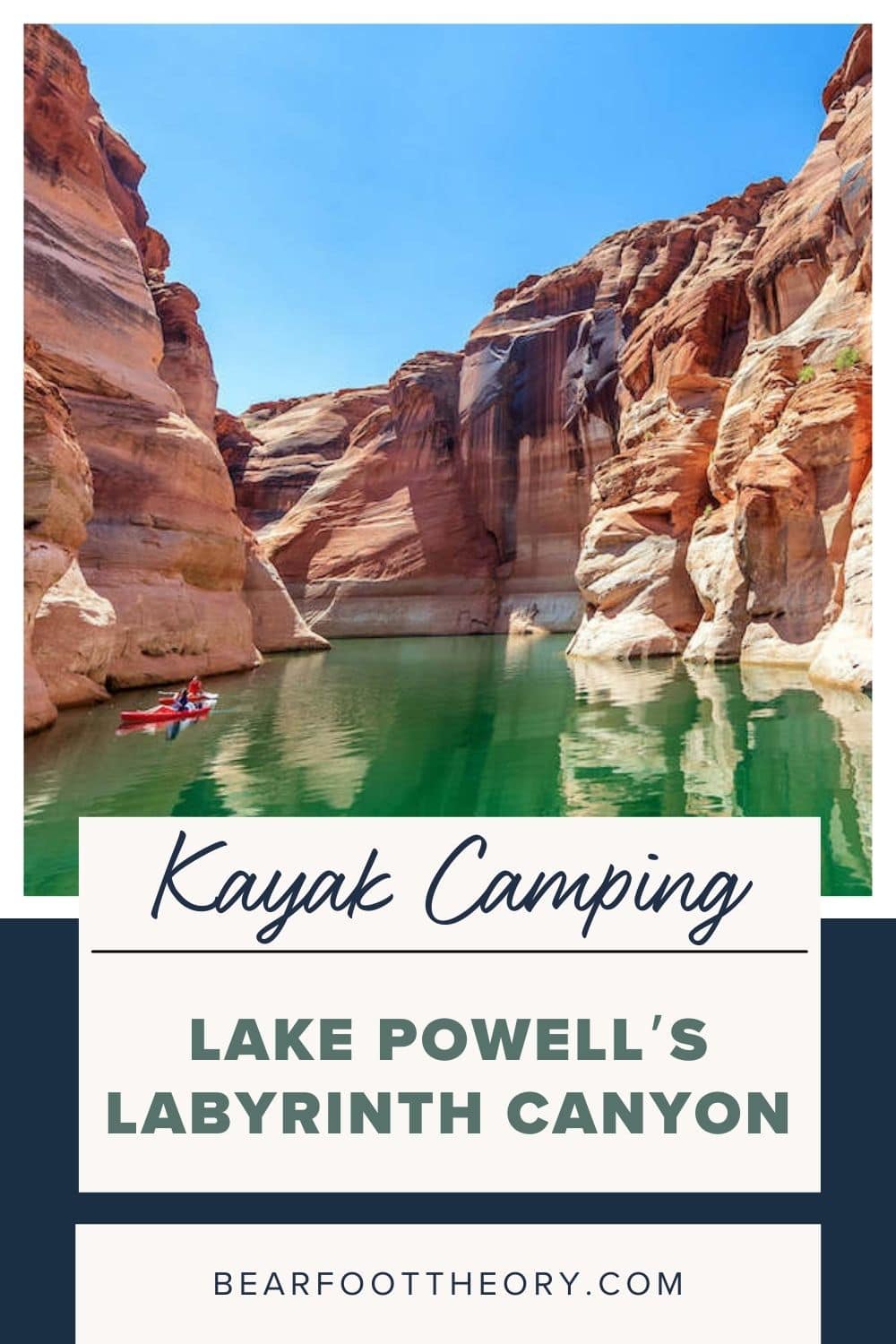
Some fantastic shots. Is that 4th-ish image shot with a fisheye?
Thanks Yok! I shot that one with my GoPro Hero4 Black.
Ahhh…so that shot must be in the ultra wide mode. I haven’t invested in a Hero yet. I jumped forward with a Canon 6D with the pro 24-70 lens. Serious glass…and serious weight!
I suspect that if you are using the Hero 4 B you recommend it? Any practical downsides?
It’s just the normal gopro mode, but I think the angle made it look fisheye like. I love my Hero4. Here’s more tips in case you decide to get one:
https://bearfoottheory.com/best-go-pro-tips-and-tricks-awesome-travel-photos/
Did you need a roof rack for the kayaks?
I just have two cross bars and no special rack on the top of my Subaru.
THANKS for this info! This’ll be an epic use of our kayaks in AZ!
Awesome! Those pictures are great! Kayaking is so much fun! Glad to see you enjoyed yourself! Thanks so much for sharing this fabulous guide!
How did you get back to Wahweap? Paddle all the way back? I love your site by the way.
No, we got a boat taxi to pick us up. If you paddle back, you’d want to spread it out over a couple of days.
Hey! Thank you for this post. I’ve been wanting to kayak Lake Powell since I bought my kayak last year! I’m wondering about what your next trip might look like. This would be my first overnight kayaking trip, do you think launching at Lone Rock would be good to avoid having to taxi? Any idea where you would camp/explore if leaving from that launch point? Also, I would take my own kayak, paddle and life vest. I’ll take a look at your gear list, but I’m wondering how much stuff you ended up with on your boat. I do have a little storage spot in the back like the pictures you’ve posted and some room at my feet. Did you have a spray skirt on your kayak? Thank you so much!
Yes Lone Rock would be a good one for your first trip. Logistically its much easier. You’ll need a couple of small dry bags and you can stuff as much as you can in the storage compartments. The rest can be strapped on top of your kayak. I didn’t use a spray skirt, but I think it depends on what time of year you go with the water temps.
About how much would you say a boat taxi would cost from where you got picked up?
I found this info: There are two licensed companies on Lake Powell that provide water shuttles: Aramark Executive Services (928-645-1037, out of Wahweap Marina) and Antelope Point Marina (928-645-5900). Expect to pay between $150-$200 per hour for your group. The maximum group size per water taxi is 6, but it may be less depending on the size of the water taxi available. The water taxis charge for the roundtrip time of each shuttle run.
did you arrange the taxi for the return trip ahead of time, like tell them the day/time to pick you up? i assume so but just want to check.
Hey Rob, that is a great plan to ensure you have a ride!
I’m wondering the likelihood of scoring a local to give us a one-way ride from Antelope Point to Labyrinth Canyon. Any ideas? There’s only two of us so those water taxi rates are BOLD for an 11 mile trip..
I used to Lake Powell house boat trips when I was a kid, this seems like an AMAZINGLY fun trip and I’m absolutely now planning on making this happen! I just discovered your blog today, and it’s genuinely informative and great to read!!
Congrats for the great trip. The photos are really amazing. I will definitely consider Lake Powell for my next kayak trip. I also found some videos for cliff jumping on Lake Powell – Great Blue Swimming Hole (Toilet bowl) and Hole in the Roof. Have you visited some of these places?
Nice! I did a 5 day solo kayak trip from Hall’s Crossing and paddled 35 miles to Davis Gulch up the Escalante River. It was pretty epic until the 4th day when the wind really picked up which forced me to make the 35 mile paddle out in one day the next morning. With just a few stops to stretch, it took me 8 hours to reach the marina. I believe it was June when I was there.
Thanks for sharing, Mark. A 5-day trip is a long time to be on the water, that’s great!
I just stumbled across this and it’s amazing. I want to do a 4-5 day coming up soon. How much funds should I prepare?
Hi! I read up on your Labyrinth kayak trip. 1 night. I’m wondering… Do you think it would still be enjoyable in mid March?? And what do you think about following your trip from the start, but then kayaking back to start, instead of water taxi? So a 2 night camping trip? And longer kayak back? Thanks for the tips and ideas!! We are doing havasupai trip 3 nights, then thinking 1 or 2 nights on this kayak, before heading back to KC, KS.
Hi Dana, Labyrinth Canyon in March would be enjoyable. You could totally do a 2-night camping trip there are a few people who take this itinerary.
I am going to lake Powells next year, bookmarking it, so that I can use later. Thanks for the thorough guide.
So many great places to explore. Will research this one for the future.
Did you filter water from the lake for drinking water or did you bring your own? Been googling but not finding much info on this.
Why did you choose Waheap instead of Antelope Marina? Is Antelope closer to the canyon?
I used your guide as a base to plan my Memorial Day adventure. I Kayaked to Labyrinth Canyon from State Line Boat Launch and went on a 3 day 2 night 32 mile kayaking trip: https://www.seekadventure.net/d/137-kayak-camping-to-labyrinth-canyon-on-lake-powell
Awesome! Glad you found this helpful, sounds like a rad trip that you went on!
you didn’t mention whether you paddled the 20 miles back to the Marina or whether you hired a shuttle taxi to get you back.
Thanks for info @ paddling if that’s what you did.
Kristen took the water taxi to the campground and then paddled back to the launch site. See the map under Route Options
Do you know if you can bring dogs? Would the kayak rental places let you bring a dog with a sit on top kayak and can dogs stay at the beach campsites?
Dogs are allowed in some areas on Lake Powell. You can find more information about dogs here
Climbing back into a kayak after turning over and falling out is nearly impossible. Repeat: you can not climb back into the boat if you overturn, unless you have a paddle float. [Sit-on-top kayaks CAN be climbed back onto, with some difficulty]. A paddle float, a pump, and some practice are necessary to be able to get back on and in the boat. Please be sure you understand this before you travel. You will travel much more securely when you know this procedure, and it is actually pretty simple. But like I mentioned, not possible without the paddle float. Otherwise, plan on swimming your boat and to shore if you fall out… With those steep cliffs, it could be a long swim. Good luck!
Thanks for those tips, Vincent!